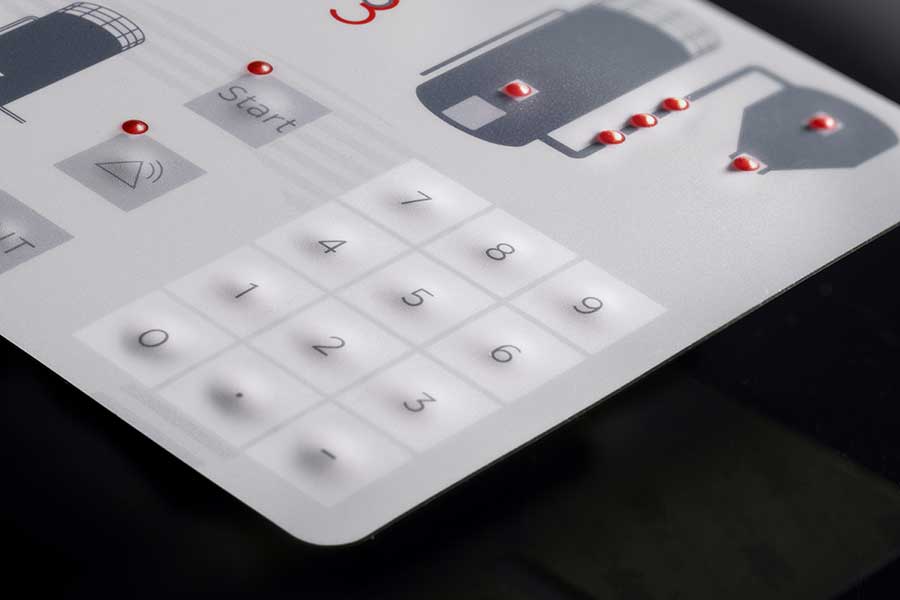Why Selecting the Right Membrane Switch Is Crucial for Your Item Style
Just How Membrane Switches Contribute to the Resilience of Electronic Control Panels
Membrane layer buttons play a critical duty in improving the sturdiness of electronic control panels, primarily via their multi-layered building and construction which supplies effective protection versus environmental factors such as dampness and dirt. The absence of moving components substantially decreases the possibility of mechanical failures, making membrane layer changes perfect for requiring applications.
Definition of Membrane Layer Buttons

Membrane switches are developed to be slim and light-weight, making them ideal for applications where space is limited. They can be produced in different forms, dimensions, and shades, offering flexibility in style that satisfies visual and useful needs. Additionally, membrane switches can incorporate different modern technologies, such as responsive feedback and LED indicators, improving individual experience.
As a result of their building, membrane layer buttons are commonly immune to dirt, dampness, and general wear, adding to their sturdiness popular environments. Their seamless style not only helps with simple cleaning however additionally minimizes the risk of mechanical failure, making them a recommended selection for suppliers looking for trustworthy customer interfaces in their digital control panels.
Protection Against Ecological Variables
The layout of membrane layer changes inherently provides a level of defense versus different environmental factors, which is vital for keeping capability in tough problems - Membrane Switch. These switches are typically created with layers of adaptable products that protect interior components from moisture, dust, and impurities. By enveloping the circuitry, membrane changes minimize the danger of short circuits and corrosion, which can dramatically harm efficiency
Furthermore, making use of durable adhesives and sealants throughout manufacturing boosts their resistance to environmental challenges. Membrane layer switches can sustain exposure to chemicals and solvents, making them ideal for markets such as food handling and health care, where health and cleanliness are extremely important. Their seamless surface area design additionally avoids the buildup of dirt and microorganisms, helping with less complicated cleaning and upkeep.
Temperature level changes are an additional environmental worry, and membrane layer switches are crafted to operate efficiently throughout a variety of temperature levels (Membrane Switch). This adaptability makes certain that control panels stay functional in various settings, from industrial settings to consumer electronics
Effect On Customer Interaction
Individual interaction with digital control board is considerably affected by the design and performance of membrane layer switches. These buttons provide a tactile interface that improves the overall user experience, permitting for intuitive navigating and control. Their responsive nature makes sure that users obtain instant responses upon activation, which is vital for tasks needing accuracy and efficiency.
In addition, the smooth surface of membrane changes facilitates easy cleaning and upkeep, advertising user confidence in the dependability of the interface. This tidiness is specifically crucial in environments where health is vital, such as medical or food processing settings. Furthermore, the compact and lightweight design of membrane layer switches over adds to the aesthetic charm of control board, motivating individual engagement through a modern and streamlined appearance.
In addition, the combination of visual elements, such as printed symbols and backlighting, assists individuals rapidly determine functions, reducing the finding out contour related to new equipment. Therefore, customers can run tools better, bring about boosted performance and satisfaction. In recap, membrane switches play a crucial duty in enhancing user communication by integrating performance, looks, and simplicity of use, inevitably causing improved operational efficiency.
Style Flexibility and Personalization
Style versatility and customization are essential facets of membrane buttons, allowing producers to tailor digital control panels to certain applications and user demands. This versatility permits the assimilation of numerous style elements, such as shades, graphics, and appearances, which can boost the aesthetic charm and user engagement of the control board.
Membrane switches can be tailored in shapes and size, accommodating a variety of gadgets and applications, from commercial equipment to customer electronic devices. This flexibility makes sure that producers can create instinctive user interfaces that straighten with individual assumptions and functional requirements. Additionally, the ability to include one-of-a-kind attributes such as backlighting or tactile feedback better boosts functionality, permitting a much more interactive experience.
In addition, the manufacturing procedure for membrane layer changes sustains the quick prototyping of layouts, enabling producers to repeat and improve their ideas quickly. This capability not only accelerates the growth timeline but additionally makes certain that the end product fulfills specific practical and aesthetic criteria.

Cost-Effectiveness and Longevity
Cost-effectiveness and durability are additional reading considerable advantages of membrane switches, look here making them an appealing alternative for makers and end-users alike. These buttons are typically less costly to create than conventional mechanical buttons, mostly because of their simplified production procedures and the minimized number of components called for. This expense advantage expands not just to preliminary production yet likewise to long-term functional costs, as membrane switches usually need less upkeep and have a reduced failure rate.
In addition, the long life of membrane switches adds to their overall value. Built from sturdy materials, they are immune to environmental variables such as wetness, dust, and chemicals, which can cause premature wear in various other switch kinds. The lack of moving parts decreases mechanical failure, allowing membrane switches over to preserve capability over prolonged durations.
This longevity is especially beneficial in applications calling for consistent efficiency under requiring conditions, such as clinical devices and commercial tools. Ultimately, the mix of cost-effectiveness and check this longevity makes membrane layer switches a financially viable option for manufacturers, offering trusted services that hold up against the test of time while optimizing monetary factors to consider.
Conclusion
In final thought, membrane layer buttons significantly enhance the resilience of digital control panels through their robust building and safety features - Membrane Switch. In general, membrane layer switches over represent a trustworthy and affordable choice for improving the long life and functionality of digital control systems.